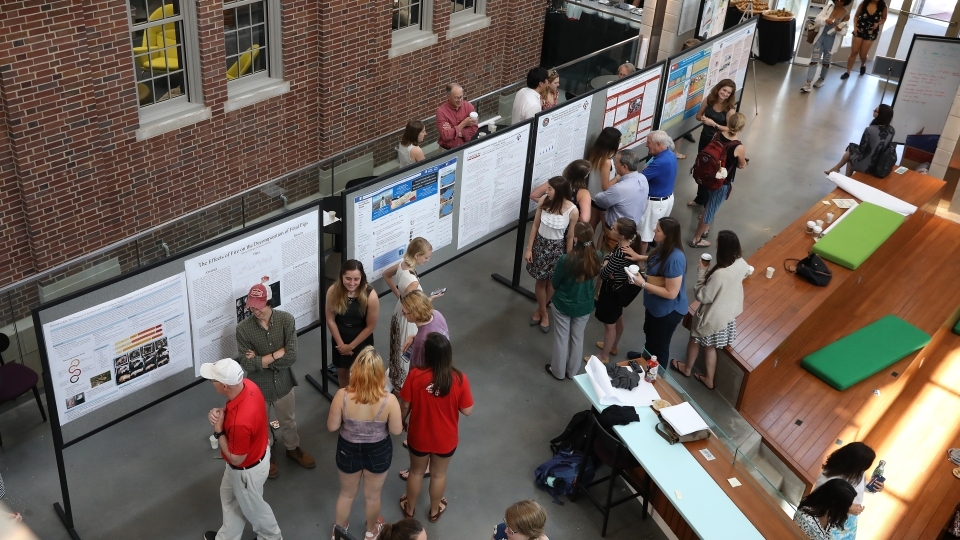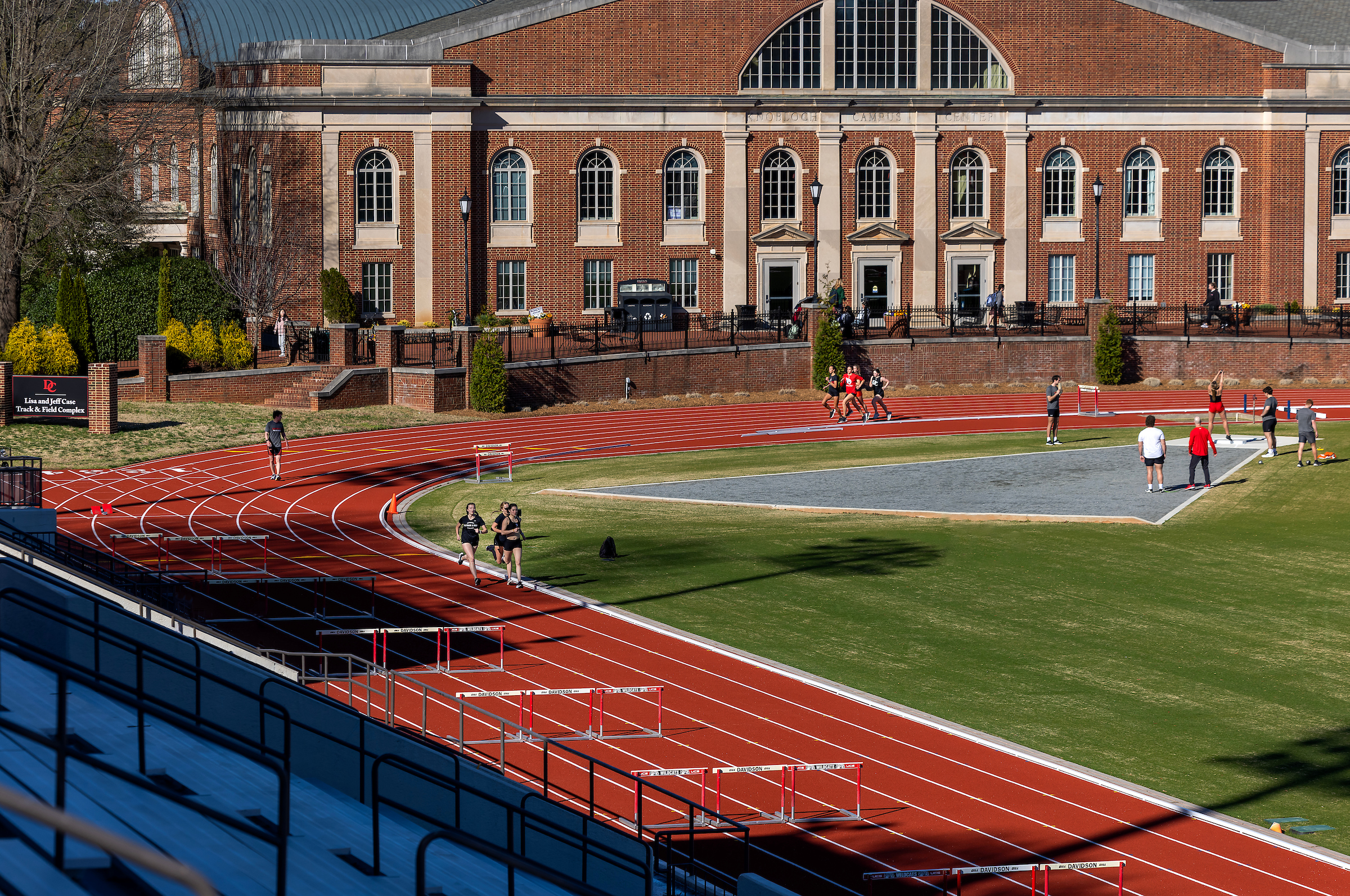From Cheaper Insulin to Stemming School Expulsions: Pre-Symposium Preview of Original Student Work With Real-World Effects
May 7, 2019
- Author
- Mary Elizabeth DeAngelis

They tackle real world problems: Tracking measles outbreaks. Developing better life-saving medications. Making mental health counseling more accessible. Keeping at-risk kids in school and out of prison.
They enliven the arts: Performing on stage. Writing poetry. Producing films. Playing music. Composing music. Painting. Drawing. Sculpting.
That’s just a small taste of what Davidson College students have been up to this year.
On May 8, the college will celebrate their accomplishments at the Verna Miller Case Research and Creative Works Symposium. The day-long event will take over campus and showcase a wide range of projects from more than 850 students.
It’s the third annual symposium, but this year comes with a new name to honor Verna Miller Case, associate dean for teaching, learning and research. Case, a longtime biology professor, will retire this year.
The event is open to anyone who wants to come. Here’s a preview of what to expect:
Owen Koucky ’19: Saving Money and Lives Through Research
When the cells in your body can’t produce certain proteins, you’re forced to rely on medications that can.
Those medications include insulin for people with diabetes, and blood clotting drugs for those with hemophilia. They can be expensive, and researchers are often looking for alternatives.
Owen Koucky ’19 believes he’s found a better, cheaper solution. But it didn’t come easily.
He had been trying out a published method that wasn’t working. Koucky had tried to dissolve amino acids, but they wound up looking like lumps of flour in gravy.
He kept trying and failing to correct the problem over the spring of 2018. On the last week of his independent study, he made a breakthrough. He figured out that if he skipped a pH correction step, the amino acids dissolved and he could produce any protein he wanted.
Koucky, who is a Baker-Vagt Scholar, has since made other improvements to protocols to enhance protein production. He worked on his genomics project with Brown Professor of Biology Malcolm Campbell. Together, they have a paper ready to submit to a science journal for publication.
“We want to share our insights so other labs can use our approach,” Koucky said.
Campbell said the research will help a growing number of labs. He says a teardrop size of ingredients cost $500 to buy, but Koucky can make it for less than $50.
“Owen is a pioneer at Davidson for making proteins outside of cells,” Campbell said. “He fixed a protocol that was broken.”
“Each time he produces a batch of the materials, he’s making the equivalent of $150,000 of the commercial product,” Campbell said. “I’m impressed by how much he’s accomplished. It’s just great. His method works much better than the expensive store brand.”
Mikayla Smalls ’20: Disrupting the School-to-Prison Pipeline
It’s a pattern often repeated in America’s public schools.
It starts when students with behavioral issues get suspended or expelled. While school’s in session they’re home or out on the streets putting themselves on a path to more potential trouble. If they’re Black, their chances of being suspended and ending up in prison escalate dramatically.
Mikayla Smalls ’20 says schools can do much more to stop the cycle.
Her project is “Disrupting the School-to-Prison Pipeline: An Analysis of Mentoring Programs.” She maintains that it’s much smarter to offer strong mentoring programs than to force kids out of school and into more self-destruction.
A 2018 federal report on public schools showed that while Black students made up 15 percent of the population, they accounted for 39 percent of school suspensions. Students forced to leave school were twice as likely to be arrested and end up in the criminal justice system.
Smalls says that instead of expulsion, students could be placed in a school program that helps them modify behavioral issues. The setting would be a safe space where teachers and mentors work closely with students to get to the heart of the issues they’re experiencing.
Smalls said that the intensive attention and support of caring adults would help students overcome academic and social obstacles and keep them coming to school.
“We would destigmatize suspension and turn it into something positive,” she said.
Smalls’ inspiration came from her work with “Seeds of Magic,” an initiative where Davidson students mentor West Charlotte High School students. The group focuses on inspiring Black girls to grow academically and emotionally “and be world changers.”
The girls often face big challenges as they navigate school, relationships, family problems, financial insecurity and future plans. Having someone who listens and understands goes a long way, Smalls said: “Sometimes we sit together and have a crying session.”
A Bonner Scholar, Smalls carries a double major in Africana studies and sociology. She produced her project for “Community Engagement and Change,” a Sociology course taught by Stacey Riemer, associate dean of students and director of the Center for Civic Engagement.
“Mikayla’s project is a shining example of public scholarship that takes into account the values of mutuality and reciprocity,” Riemer said. “Through her ongoing involvement with Seeds of Magic and study of community change, she has developed a model program to support students who are under-resourced.”
Smalls, who’s from the Atlanta area, said she started mentoring students in high school.
“I’ve always seen mentorship as an essential part of building community and motivating others to grow and achieve their goals. As a mentor, I aim to do just that,” Smalls said. “I want to share my experience as a Black woman and give advice to the girls in hopes of them understanding the realities of this world.”
Alex Hazan ’20: Modeling the Effects of the Anti-Vax Movement
It started as a connect-the-lines-and-dots project.
As it evolved, Alex Hazan ’20 wondered about the connections in the network of a spreading disease. He and his professor then talked about the role of vaccines in preventing wide-spread outbreaks.
“We had a moment when we realized our work could apply to the anti-vax movement,” Hazan said. “And then more and more headlines kept coming out about measles outbreaks, so I focused on that.”
Hazan’s project is called, “Effects of the Anti-Vax Movement on Herd Immunity in School Districts: A Network Approach.” Herd immunity occurs when a significant majority of a population is vaccinated, effectively insulating any vaccinated people from disease.
Hazan developed a simulation model based on 1,500 people in six school districts. He divided students, teachers and parents into separate categories. He recorded the normal connections they would make with each other, and eventually, with people in other districts.
Then he simulated a series of measles outbreaks. He examined the spread of measles in populations where vaccinations were evenly spread through the districts and in those where anti-vaxers were concentrated in one or two districts.
In his research, overall infection rates dropped significantly when 75 percent of people in the initial point of contact area were vaccinated. Districts where anti-vaxers were evenly spread out prevented spreading the contagion between districts, even when someone who was vaccinated became ill. (The measles vaccination is considered to be 97 percent effective, so he included that three percent scenario.)
Districts where unvaccinated people were more concentrated were more likely to spread the measles to other districts.
“Concentrating anti-vaxers made the disease spread much quicker and compromised the herd immunity,” Hazan said.
Hazan, a computer science major with a minor in economics, said he’d never used a public health situation in his research. He created the network simulation model for his computational economics course.
“I had a sense of validation that the work I’d done had some real world affects and addressed real world problems,” he said.
“I was happy to mentor him, but this was the result of his hard work,” said economics professor Shyam Gouri Suresh. “It’s very high quality, and I think he has the talent and drive to take it further.”
Grace Coleman ’21: Making Counseling Services More Accessible
For many college students, the end of a semester causes extra stress, with final papers, projects and exams looming.
That academic stress will send some students to a counselor. Others may go because of persistent sadness, relationship problems or a negative body image. Or they may feel intense grief and anxiety after a mass shooting at a school, concert venue or worship place.
Whatever their reasons, the number of college students seeking counseling is on the rise. Grace Coleman ’21 wants to make that counseling more accessible.
She’s working with the Davidson College Counseling Center to develop a web application that would make it more convenient for students to get on a wait list for a walk-in appointment with a counselor.
As it stands, the college has five licensed counselors who work with students on a largely appointment basis. Counselors rotate so that one covers walk-in duty from 1-4 p.m. each day, she said.
Coleman’s plan will let students tap into the website to learn how many people are waiting to see the walk-in duty counselor. They’d be able to fill out forms online, which would save office time.
“I think some students hesitate to seek help,” Coleman said. “Having this as a web application is a huge stepping stone. In our busy days we don’t seem to have the time and space to sit and wait for an appointment.”
Coleman will continue working on the project through a computer science fellowship this summer. Her symposium poster shows the website in its design phase. She wants the site to have a calming, soothing appearance to make people feel safe and comfortable. The website will also offer tips for reducing anxiety and stress while they’re waiting for a counselor’s assessment.
“Not everybody needs a counselor, but everyone needs to know somebody cares,” said Counseling Center Director Trish Murray, who has worked closely with Coleman on the project.
“This will be a great service to reinforce that,” Coleman said.
A recent national study showed that in 2016, 20 percent of people between the ages of 18 to 26 reported seeking help for an anxiety disorder. That’s up from 10 percent in 2008, according to the The University of California Berkley study.
Experts cite a variety of reasons for the rise -- including an increased awareness about the importance of mental health treatment.
Laurie Heyer, faculty director for the Jay Hurt Hub for Innovation and Entrepreneurship, is Coleman’s advisor. She said the recent mass shooting that killed two students and wounded four others at nearby UNC Charlotte starkly emphasizes the need for counseling services.
“Right now, everyone is reeling from the tragedy at UNCC, and it’s deeply affecting a lot of students who need to talk to somebody and don’t know how to do that,” Heyer said. “This project has such potential for changing lives at the college. Grace is providing a service that will benefit students for years to come.”
The Verna Miller Case Research and Creative Works Symposium will begin Wednesday, May 8, at 8:45 a.m. and end with a closing celebration at 4:15 p.m. All events will take place in, or in facilities surrounding, Richardson Plaza, which is located between the E.H. Little Library and Chambers Building.


